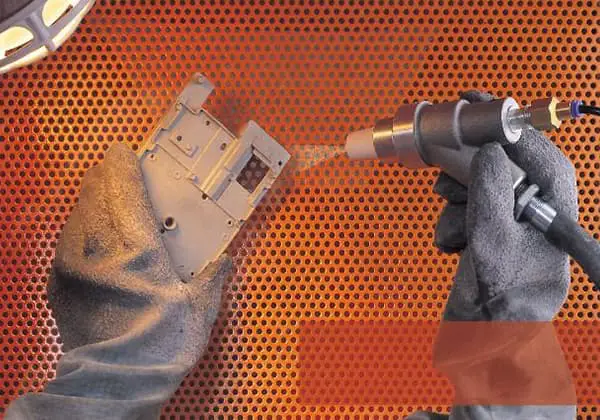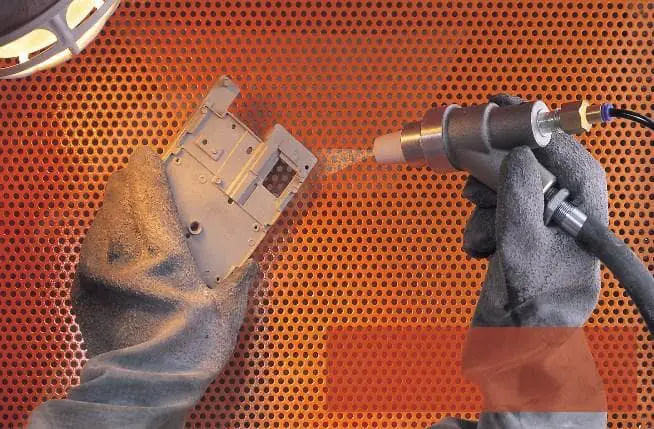
Have you ever wondered how sandblasting can transform a surface? In this blog post, we’ll dive into the fascinating world of sandblasting, exploring its applications, process, and different types of machines. Our expert mechanical engineer will guide you through the intricacies of this powerful technique, revealing how it can enhance the properties and appearance of various materials. Get ready to discover the science behind the blast!

Sandblasting uses compressed air as a power source to create a high-speed jet stream that propels abrasive materials (such as copper ore sand, quartz sand, diamond sand, iron sand, and Hainan sand) onto the surface of the workpiece that needs to be treated. This causes changes in the outer surface or shape of the workpiece’s surface.

Due to the impact and cutting action of the abrasive material on the workpiece’s surface, the surface of the workpiece obtains a certain degree of cleanliness and different levels of roughness, thereby improving the mechanical properties of the workpiece’s surface.
As a result, the fatigue resistance of the workpiece is enhanced, the adhesion between the workpiece and the coating is increased, and the durability of the coating is prolonged. This method is also beneficial for the leveling and decoration of the coating.
(1) Sandblasting for pre-treatment of workpieces before coating or adhesive can remove all pollutants such as rust and establish a crucial surface texture, commonly known as “matte surface.” Different roughness levels can be achieved by using different grit sizes of abrasive material, such as the abrasive of sandblasting equipment, which greatly improves the adhesion between the workpiece and coating or plating, or strengthens the adhesion of the adhesive joints and enhances the quality.
(2) Sandblasting can clean all pollutants on the surface of castings and heat-treated workpieces, such as residual oxide and oil stains, and polish the surface to improve the workpiece’s smoothness. This process can present a uniform metal color, making the appearance of the workpiece more beautiful and attractive.
(3) Sandblasting can clean the small burrs on the surface of machined parts and make the surface smoother, eliminating the harm of burrs and improving the quality of the workpiece. Sandblasting can also create small rounded corners at the junction of the workpiece’s surface, making it more beautiful and precise.
(4) After sandblasting, the mechanical parts can produce uniform and fine concave-convex surfaces on the surface, which can store lubricating oil, improve lubrication conditions, reduce noise, and extend the service life of the machinery.
(5) Sandblasting can achieve different levels of reflectivity or sub-gloss for some special workpieces, such as polishing stainless steel, plastic, and jade, sub-glossing the surface of wooden furniture, creating patterns on sandblasted glass surfaces, or fuzzing the surface of fabrics. It can also play a decorative role.
The pre-treatment stage of sandblasting process refers to the surface treatment that should be carried out on the workpiece before it is sprayed or coated with a protective layer.
The quality of pre-treatment stage in sandblasting process affects the adhesion, appearance, moisture resistance, and corrosion resistance of the coating. If the pre-treatment is not done properly, rust will continue to spread under the coating, causing the coating to peel off in pieces.
The lifespan of a coating can differ by 4-5 times between a carefully cleaned surface and a generally cleaned workpiece when using exposure method for coating comparison. There are many methods for surface cleaning, but the most widely accepted methods are solvent cleaning, acid pickling, manual tools, and power tools.
The sandblasting process uses compressed air as power to form a high-speed jet stream, which sprays abrasive materials onto the surface of the workpiece, causing changes in its surface appearance. Due to the impact and cutting effect of the abrasive on the surface of the workpiece, the surface obtains a certain degree of cleanliness and different roughness, thus improving the mechanical performance of the workpiece surface.
Sandblasting machines are the most widely used products in abrasive jet machining. Sandblasting machines are generally divided into two categories: dry sandblasting machines and liquid sandblasting machines. Dry sandblasting machines can be further divided into suction-type and pressure-type.
I. Suction-type Dry Sandblasting Machines
II. Pressure-type Dry Sandblasting Machines
III. Liquid Sandblasting Machines
Compared to dry sandblasting machines, the biggest advantage of liquid sandblasting machines is the effective control of dust pollution during the sandblasting process, which improves the working environment of sandblasting operators.
Also known as cleanliness, there are two representative international standards: one is the “SSPC-” formulated by the United States in 1985, and the other is the “Sa-” formulated by Sweden in 1976, which is divided into four levels, namely Sa1, Sa2, Sa2.5, and Sa3. It is a commonly used international standard, and the detailed introduction is as follows:
Sa1 level – equivalent to the US SSPC-SP7 level. The general and simple manual brushing and sanding method is used. This is the lowest level of the four levels of cleanliness, and the protection of the coating is only slightly better than that of untreated workpieces. The technical standards for Sa1 level treatment: the workpiece surface should not have visible dirt such as oil, grease, residual oxide skin, rust spots, and residual paint. Sa1 level is also called manual brushing cleaning level (or sweeping level).
Sa2 level – equivalent to the US SSPC-SP6 level. Sandblasting cleaning method is used, which is the lowest level of sandblasting treatment, that is, the general requirement, but the protection of the coating is much higher than that of manual brushing cleaning. The technical standards for Sa2 level treatment: the workpiece surface should not have visible oil, dirt, oxide skin, rust, paint, oxide, corrosion, and other foreign substances (excluding defects), but the defects are limited to no more than 33% of the surface area per square meter, including slight shadows; slight discoloration caused by defects and rust corrosion; oxide skin and paint defects. If there are grooves on the original surface of the workpiece, slight rust and paint will remain at the bottom of the groove. Sa2 level is also called commercial cleaning level (or industrial level).
Sa2.5 level – is commonly used in industry and can be used as an acceptance technical requirement and standard level. Sa2.5 level is also called near-white cleaning level (near-white or out-white level). The technical standards for Sa2.5 level treatment: the same as the first half of Sa2 requirements, but the defects are limited to no more than 5% of the surface area per square meter, including slight shadows; slight discoloration caused by defects and rust corrosion; oxide skin and paint defects.
Sa3 level – equivalent to the US SSPC-SP5 level, is the highest level of treatment in industry, also called white cleaning level (or white level). The technical standards for Sa3 level treatment: the same as Sa2.5 level, but 5% of shadows, defects, rust corrosion, etc. must not exist.
Sandblasting: A technical term for gold and silver coin casting technology. It involves using metal sand particles of various sizes and shapes on the production mold of gold and silver coins to spray the patterned areas into extremely detailed frosted surfaces. During the production of gold and silver coins, a beautiful silver layer appears on the patterned areas, enhancing the sense of three-dimensionality and layering.
Sandblasting (referring to rust removal or plating on metal surfaces) uses quartz sand, ordinary quartz sand, and refined quartz sand: with high hardness and good rust removal effects, the physical and chemical indicators are as follows: SiO2≥98—99.8%, Fe2O3≤0.06—0.005%, refractoriness of 1750-1800℃, uniform particle appearance, commonly used particle sizes are 1-3MM and 0.1-0.3MM, pure white.
The particle size range is mostly between 5 and 220 mesh and can be produced according to user requirements. Its main uses are in the metallurgical, silicon carbide, glass and glass products, enamel, steel casting, water filtration, alkali soaking of flowers, chemical, and sandblasting industries.








